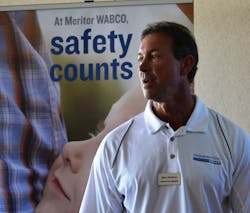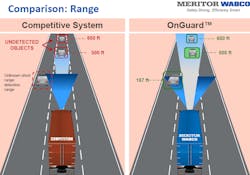OnGuard Active combines radar-based detection, brake assist technology
GRAND PRAIRIE, TEXAS. Given the frequency and severity of truck crashes with stationary objects, Meritor Wabco is beefing up its radar-based collision mitigation system. And, as company officials demonstrated at Lone Star Park here Thursday, when the smoke gets in your eyes, OnGuard Active will detect an object in the road in zero-visibility conditions and can apply full braking without driver intervention.
The premise is statistically straightforward, as Mark Melletat, director of field operations, explained: Collision mitigation systems could prevent 3,500 rear-end collisions, a benefit of $2.5 billion according to the company’s analysis of government highway crash statistics.
The newest version, OnGuard Active, is designed to reduce the severity of or prevent the 20 percent of those accidents that are related to stationary objects—and 30 percent of those crashes are fatal. The key to the upgrade is the ability to spot and respond automatically to a vehicle that has stopped in the road ahead.
Melletat emphasized the superiority of radar over vision systems in low-visibility situations, and also explained that OnGuard Active uses a high-resolution, multi-beam long and short radar. The wide-beam identifies objects in adjacent lanes (allowing the system to provide an “evasive maneuver check”) while the long beam identifies objects 650 feet ahead.
In a limited visibility situation, “essentially what the driver would see is nothing,” Melletat said. “What the radar sees is identification of those vehicles, understanding where they are positioned and if they’re an imminent threat.”
Additionally, the upgrade will add full-braking capability, compared to the current parameter settings with a 50% maximum. Additionally, the system has the ability to boost driver braking if more stopping power is indicated. Braking events are preceded by audio and visual effects in the cab, and a “haptic alert,” or physically alerting the driver by quickly pumping the brake pedal.
Customers who have already installed the current generation of OnGuard will be able upgrade their units, and OnGuard Active, as an essentially software solution, will be priced about the same.
“We can’t advertise we prevent all collisions,” Melletat said. “But we’re mitigating, we’re scrubbing energy in all instances.”
OnGuard active will launch at the end of the year. The company is also moving into the vocational market and has just announced coming availability on the Freightliner M2 series of trucks.
About the Author
Kevin Jones 1
Editor
Kevin has served as editor-in-chief of Trailer/Body Builders magazine since 2017—just the third editor in the magazine’s 60 years. He is also editorial director for Endeavor Business Media’s Commercial Vehicle group, which includes FleetOwner, Bulk Transporter, Refrigerated Transporter, American Trucker, and Fleet Maintenance magazines and websites.

